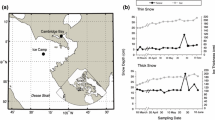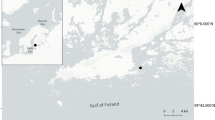Abstract
Microbial community dynamics within the fast sea ice of Prydz Bay (68°S 78°E) were investigated over an annual cycle at two sites (1 and 3 km offshore) between April and November 2008. There are few long-term sea ice studies, and few that cover the phase of winter darkness when autotrophic processes are curtailed. Mean chlorophyll a concentrations in the ice column ranged between 0.76 and 44.8 μg L−1 at the 1-km site (Site 1) and 3.11–144.6 μg L−1 at the 3-km site (Site 2). Highest chlorophyll a usually occurred at the base of the ice. Bacterial concentrations ranged between 0.30 and 2.08 × 108 cells L−1, heterotrophic nanoflagellates (HNAN) between 0.21 × 105 and 2.98 × 105 cells L−1 and phototrophic nanoflagellates (PNAN) 0–1.06 × 105 cells L−1. While HNAN occurred throughout the year, PNAN were largely absent in winter. Dinoflagellates were a conspicuous and occasionally an abundant element of the community (maximum 17,460 cells L−1), while ciliates were sparse. The bacterial community showed considerable morphological diversity with a dominance of filamentous forms. Bacterial production continued throughout the year ranging between 0 and 22.92 μg C L−1 day−1 throughout the ice column. Lowest rates occurred between late June and early August. The sea ice sustained an active and diverse microbial community through its annual extent. The data suggest that during winter darkness the microbial community is dominated by heterotrophic processes, sustained by a pool of dissolved organic carbon.









Similar content being viewed by others
References
Archer SD, Leakey RJG, Burkill PH, Sleigh MA, Appleby CJ (1996) Microbial ecology of sea ice at a coastal Antarctic site; community composition, biomass and temporal change. Mar Ecol Prog Ser 135:179–195
Becquevort S, Dumont I, Tison J-L, Lannuzel D, Sauvée M-L, Chou L, Schoemann V (2009) Biogeochemistry and microbial community composition in the sea ice and underlying seawater off East Antarctica during early spring. Polar Biol 32:879–895
Dumont I, Schoemann V, Lannuzel D, Chou L, Tison J-L, Becquevort S (2009) Distribution and characterization of dissolved and particulate organic matter in Antarctic pack ice. Polar Biol 32:733–750
Eichen H (2003) From the microscopic, to the macroscopic to the regional scale: growth, microstructure and properties of sea ice. In: Thomas DN, Dieckmann GS (eds) Sea ice an introduction to its physics, chemistry, biology and geology. Blackwell, New York, pp 22–81
Garrison DL, Buck KR (1991) Surface-layer sea ice assemblages in Antarctic pack ice during the austral spring: environmental conditions, primary production and community structure. Mar Ecol Prog Ser 75:161–172
Gosselin M, Legrande L, Therriault SG, Rochet M (1986) Physical control of the horizontal patchiness of sea-ice algae. Mar Ecol Prog Ser 29:289–298
Grossman S, Dieckmann GS (1994) Bacterial standing stock, activity and carbon production during formation and growth of sea ice in Weddell Sea, Antarctica. Appl Environ Microbiol 60:2746–2753
Günther S, Dieckmann GS (1999) Seasonal development of algal biomass in snow-covered fast ice and the underlying platelet layer in the Weddell Sea, Antarctica. Antarct Sci 11:305–315
Günther S, Dieckmann GS (2001) Vertical zonation and community transition of sea-ice diatoms in fast ice and platelet layer, Weddell Sea, Antarctica. Ann Glaciol 33:287–296
Helmke E, Weyland H (1995) Bacteria in sea ice and underlying water of the eastern Weddell Sea in midwinter. Mar Ecol Prog Ser 117:269–287
Kaartokallio H (2004) Food web components, and physical and chemical properties of Baltic Sea ice. Mar Ecol Prog Ser 273:49–63
Kaartokallio H, Tuomainen J, Kuosa H, Kuparinen J, Martikainen PJ, Servomaa K (2008) Succession of sea-ice bacterial communities in the Baltic Sea fast ice. Polar Biol 31:783–793
Kattner G, Thomas DN, Hass C, Kennedy H, Dieckmann GS (2004) Surface ice and gap layers in Antarctic Sea ice: highly productive habitats. Mar Ecol Prog Ser 277:1–12
Kirchman DL (2001) Measuring bacterial biomass production and growth rates from leucine incorporation in natural environments. In: Paul JH (ed) Methods in microbiology. Marine microbiology, vol 30. Academic Press, London, pp 227–237
Kottmeier ST, Sullivan CW (1987) Late winter primary production and bacterial production in sea ice and seawater west of the Antarctic Peninsula. Mar Ecol Prog Ser 36:287–298
Krell A, Schnack-Schiel SB, Thomas DN, Kattere G, Zipan W, Dieckmann GS (2005) Phytoplankton dynamics in re;ation to hydrography, nutrients and zooplankton at the onset of sea ice formation in the eastern Weddell Sea (Antarctica). Polar Biol 28:700–713
Krembs C, Gradinger R, Spindler M (2000) Implications of brine channel geometry and surface area for the interaction of sympagic organisms in Arctic sea ice. J Exp Mar Biol Ecol 248:55–80
Kuparinen J, Autio R, Kaartokallio H (2011) Sea ice bacterial growth rate, growth efficiency and preference for inorganic nitrogen sources in the Baltic Sea. Polar Biol 34:1361–1373
Laurion I, Demers S, Vézina AF (1995) The microbial food web associated with the ice algal assemblage; biomass and bacterivory of nanoflagellate protozoans in Resolute Passage (High Canadian Arctic). Mar Ecol Prog Ser 120:77–87
Laybourn-Parry J, Marshall WA, Marchant HJ (2005) Flagellate nutritional versatility as a key to survival in two contrasting Antarctic saline lakes. Freshw Biol 50:830–838
Marchant HJ, Scott FJ (1993) Uptake of sub-micrometer particles and dissolved organic matter by Antarctic choanoflagellates. Mar Ecol Prog Ser 92:59–64
McMinn A, Ryan K, Gademann R (2003) Diurnal changes in photosynthesis of Antarctic fast ice algal communities determined by pulse amplitude modulated fluorometry. Mar Biol 143:359–367
Meiners K, Brinkmeyer R, Granskog MA, Lindfors A (2004) Abundance, size distribution and bacterial colonization of exopolymer particles in Antarctic sea ice (Bellinghausen Sea). Aquat Microb Ecol 35:283–296
Michel C, Legrande L, Demers S, Therriault J-C (1988) Photoadaptation of sea-ice microalgae in springtime: photosynthesis and carboxylating enzymes. Mar Ecol Prog Ser 177:177–185
Moorthi S, Caron DA, Gast RJ, Sanders RW (2009) Mixotrophy: a widespread and important ecological strategy for planktonic and sea-ice nanoflagellates in the Ross Sea, Antarctica. Aquat Microb Ecol 54:269–277
Palmisano AC, SooHoo JB, Moe RL, Sullivan CW (1987) Sea ice microbial communities. VII. Changes in under-ice spectral irradiance during the development of Antarctic sea ice microalgal communities. Mar Ecol Prog Ser 35:165–173
Parsons TR, Maita Y, Lalli CM (eds) (1984) A manual of chemical and biological methods for seawater analysis. Pergamon Press, Oxford
Pearce I, Davidson AT, Bell EM, Wright S (2007) Seasonal changes in the concentration and metabolic activity in bacteria and viruses at an Antarctic coastal site. Aquat Microb Ecol 47:11–23
Raymond JA, Knight CA (2003) Ice binding, recrystallization inhibition, and cryoprotective properties of ice active substances associated with Antarctic sea ice diatoms. Cryobiology 46:174–181
Roberts EC, Laybourn-Parry J (1999) Mixotrophic cryptophytes and their predators in the Dry Valley lakes of Antarctica. Freshw Biol 41:737–746
Sanders RW, Porter KG (1988) Phagotrophic phytoflagellates. Adv Microb Ecol 10:167–192
Sime-Ngando T, Demer S, Juniper SK (1999) Protozoan bacterivory in the ice and the water column of a cold temperate lagoon. Microbial Ecol 37:95–106
Smith DC, Azam F (1992) A simple economical method for measuring bacterial protein synthesis rates in sea water using [3H] leucine. Mar Microb Food Webs 6:107–109
Søgaard DH, Kristensen M, Rysgaard S, Glud RN, Hansen PJ, Hilligsøe KM (2010) Autotrophic and heterotrophic activity in Arctic first-year sea ice: seasonal study from Malene Bight, SW Greenland. Mar Ecol Prog Ser 419:31–45
Stoecker DK, Buck KR, Putt M (1993) Changes in the sea-ice brine community during the spring-summer transition, McMurdo Sound, Antarctica II. Phagotrophic protists. Mar Ecol Prog Ser 95:103–113
Stoecker DK, Gustafson DE, Merrell JR, Black MMD, Baier CT (1997) Excystment and growth of crysophytes and dinoflagellates at low temperatures and high salinities in Antarctic sea-ice. J Phycol 33:585–595
Stoecker DK, Gustafson DE, Black MMD, Baier CT (1998) Population dynamics of microalgae in the upper land-fast sea ice at a snow free location. J Phycol 34:60–69
Talling JF (1969) General outline of spectrophotometric methods. In: Vollenweider RA (ed) A manual for measuring primary production in aquatic environments, IBP Handbook no. 12. Blackwell, Oxford, pp 2–24
Thomas DN, Dieckmann GS (2002) Antarctic sea ice—a habitat for extremophiles. Science 295:641–644
Thomas DN, Kennedy H, Kattner G, Gerdes D, Gough C, Dieckmann GS (2001a) Biogeochemistry of platelet ice: its influence on particle flux under fast ice in the Weddell Sea, Antarctica. Polar Biol 24:486–496
Thomas DN, Kattner G, Engbrodt R, Giannelli V, Kennedy H, Haas C, Dieckmann GS (2001b) Dissolved organic matter in Antarctic sea ice. Ann Glaciol 33:297–303
Thomson PG, McMinn A, Kiessling I, Watson M, Goldsworthy PM (2006) Composition and succession of dinoflagellates and chrysophytes in the upper fast ice of Davis Station, East Antarctica. Polar Biol 29:337–345
Thurman J, Parry JD, Hill P, Laybourn-Parry J (2010) The filter-feeding ciliates Colpidium sp. and Tetrahymena pyriformis display selective feeding behaviours in the presence of mixed bacterial prey. Protist 161:577–588
Tranvik LJ, Porter KG, Sieburth JMcN (1989) Occurrence of bacterivory in Cryptomonas a common freshwater phytoplankter. Oecologia 78:473–476
Underwood GJC, Fietz S, Papadimitriou S, Thomas DN, Dieckmann GS (2010) Distribution and composition of dissolved extracellular polymeric substances (EPS) in Antarctic sea ice. Mar Ecol Prog Ser 404:1–19
Acknowledgments
We are indebted to the support of the Davis expeditioners during 2008/09 for their assistance with fieldwork. This work was funded by grants from the University of Tasmania and the Australian Antarctic Research Assessment Committee.
Author information
Authors and Affiliations
Corresponding author
Rights and permissions
About this article
Cite this article
Paterson, H., Laybourn-Parry, J. Sea ice microbial dynamics over an annual ice cycle in Prydz Bay, Antarctica. Polar Biol 35, 993–1002 (2012). https://doi.org/10.1007/s00300-011-1146-3
Received:
Revised:
Accepted:
Published:
Issue Date:
DOI: https://doi.org/10.1007/s00300-011-1146-3




